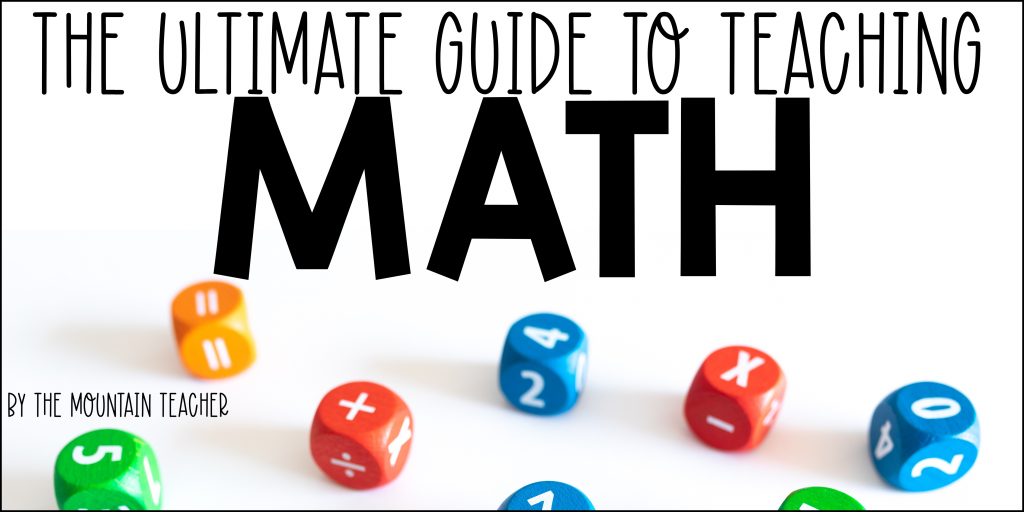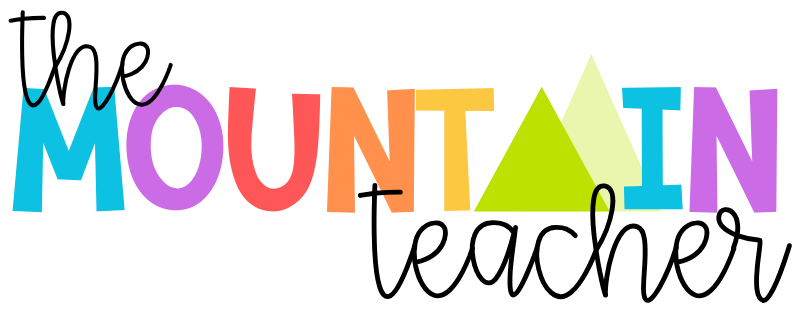How to Set Up EVERYTHING in Your Math Classroom To Make Life Easier

Are you looking to set up your math classroom so it runs like a well oiled machine? Whether you are teaching 2nd grade specifically, or any primary elementary grade, this guide is for you. Teaching math is my passion and there are so many great EASY TO USE strategies that you can implement in your classroom TODAY. Let’s take a look.

Timing
Before setting up your math block, it is important to know what kind of time you are working with. Typically, most math blocks I have seen are between 60-120 minutes, with the most average being 90 minutes. No matter what you are working with, you are going to want to divide that time intentionally into the following categories:
- Warm Up (5-10 minutes)
- Mini Lesson (10-15 minutes – NO MORE THAN 20!)
- Small Groups and Centers (This is where your extra time goes. Anywhere from 30-90 minutes)
- Closing (5 minutes)

Warm Up
I have experimented with a few different math warm ups, and they all have been successful. To best determine what works for you and your students, try a few and see which sticks.
My favorite warm up is to have students come in, pull out a math notebook or white board, and do 4 warm up problems. Typically, 3 problems are from the day or lessons before and 1 is a new concept that we will be discussing during the mini lesson today. I give students about 5 minutes to complete the problems, then we move into the whole group mini lesson where I begin by going over the problems as a class.
Other great warm ups include fluency practice, math journaling, playing a daily whole group game such as I Have, Who Has, allowing students to explore math manipulatives, discussing a problem of the day, a daily math calendar, or a number of the day.

Whole Group Mini Lesson
Timing on your whole group lesson is EVERYTHING. Your lesson needs to be thorough but brief. This means that you are not going over 20 minutes long, but are explicitly teaching the new skill students will need to know for that day. Try to focus on no more than one specific skill per day, to keep students from being confused.
It is a great idea to CREATE an anchor chart or visual plan WITH your students that includes clear steps on how to solve the problems. This makes it easy to refer back to when students might get stuck on a certain concept and also gives students something to refer to if they are working independently.

Small Groups
Small groups are an essential part of your math block and should not be overlooked. It is essential that you see at least one small group a day, but ideally, you should meet with every small group every day. One small group can be anywhere from 8-15 minutes long, but ideally not too much longer, as that will not be developmentally holding student attention.
Level students into groups either based on their abilities (pre-test scores) or heterogeneously and have mixed ability groups. Either way, you are sure to find success as long as you are meeting daily.
Students should be practicing the skill of the day during small groups with the teacher. This is how you prevent students from practicing a skill wrong, and it enables you to help students achieve mastery. Typically, I keep students at my back table until they show they have mastered the skill, then I send them off to continue working on the activity or worksheet of the day independently. They know that if they have questions, they are always welcome to return or to remain at my table.
With your higher achieving students, you can have them start the work on their own and quickly go over it at your back table. If they all seem to be getting it and on the same page, this is a great time to begin doing enrichment activities such as project based learning, challenge of the day activities, logic activities, or more advanced skills.
Centers
Centers are what the rest of your class is doing while you are meeting with your small groups. There are a lot of different options to set up your math classroom and a lot of different ways to run it.
As with most teaching concepts, there are multiple ways to set up centers in your classroom. None is better than the other, they all have pros and cons, and it will all be based on preference.

Some of the most common types of math centers are:
- Independent Math Center Games
- Group Math Center
- Task Cards
- BOOM Cards (digital)
- Buddy Games
- BUMP Games
- Project Based Learning
- Challenge Problem of the Day or Week
- Fluency Practice
- I Have, Who Has Games
- Logic Activities
- Digital Activities
- Daily Worksheets
Some of the most common ways to set up your math centers are:
- Typical Rotations – Students will be assigned to groups and will travel with their group from one center to the next. Typically there are anywhere from 3-5 centers in all.
- Dinner & Dessert – Students get a menu of must dos and may dos and can pick and choose what order they complete things in, as long as all of the must do tasks are completed.
- Build Centers – Similar to typical rotations, these centers are specifically picked to assure students are learning in different modalities. Students will use manipulatives, technology, play partner games, and more to learn about math concepts.
Closing
Typically, my closing is very brief. We usually use this time to either self-assess our work from the day (be it a worksheet or activity), to complete an exit ticket, or to talk through one last problem with a buddy. This gives me an idea on if we are ready to move onto the next topic the following day, or if we might need another day of review on the current topic.

Embedding Technology
Technology is ever changing but is also important to include during your math block in this century. There are multiple ways to include digital learning in various parts of your lesson.
- Video Warm Ups to Teach a Skill (Brain Pop, Flocabulary, Kahn Academy)
- Songs to remember important concepts
- BOOM Learning Cards
- Kahoot! Whole class games
- Digital Worksheets
- Digital Assessments
It is also important that you teach students how to answer questions that are asked on a computer. If you expect them to be using scratch paper during standardized assessments, then it is important that they practice using scratch paper on a regular basis. This means that students need frequent practice using technology in different ways to solve math problems.
Using Manipulatives
Manipulatives are an essential part of elementary math. It helps take abstract concepts and make them more concrete for all learners. Plus it is a great way to build engagement.
One important element to incorporate manipulatives in your classroom is to always let students spend a few minutes playing with manipulatives before using them. This way, they can get all of that excitement out of their system and be ready to learn when it is time to use the manipulatives appropriately.
Different manipulatives are better for different skills, so be sure to think intentionally about what you are teaching and what concept you are trying to convey before selecting which manipulatives to use.
Manipulatives can range greatly from a printed 100s chart to visual elapsed time number lines. You do NOT need them all – be sure to get a grasp on your teaching style before running to the local teacher store and buying every single manipulative in sight. Also, make use of your school’s resource room if you have one – it is likely that you will only need manipulatives for a short period of time, and then you won’t have to purchase them or store them when not in use.

Assessments
Assessing students is vital to not only see where students are at, but to make sure your instruction is clear and effective. It is important to have opportunities for formal assessment, informal assessment and self assessment embedded in your learning environment.
I assess students weekly. We do a quick 5 quiz every Friday where I ask students 1 question from each day that week and then I ask 1 question from the following week or an old skill. These assessments can either be printed or done digitally for quick results.
It is important to use the data from these assessments to drive instruction. If students do poorly, I am sure to group those students and readdress the skill they are struggling with before moving on. If the whole class does poorly, it means it is time to reteach that skill.
I also assess students at the end of each unit. This allows me to fully see how students did overall with a concept, and who might need to have extra practice either with me, with an aide or with a special educator.
Finally, I do benchmark testing at the beginning, middle and end of the year. This can come in the form of a standardized test, a district level assessment or common assessments created among teammates. I always review before these tests, and review good test taking strategies.
Scope & Sequence
If you are teaching second grade, here is my suggested order of units to set up your math classroom for the year:

Spiral Review
It is vital that after you teach one unit that you are constantly spiral reviewing. We would not want to teach place value in August and then never touch the concept again until it appears on a end of the year test in May. Be sure to throw in old skills so they are not forgotten. Do this in centers, fun class games, quick checks, computer games and other exciting ways that keeps it fun.

Homework
While I am not a large believer in homework, at some schools your hands are tied and it is mandatory. I believe a weekly homework sheet for second graders is appropriate for math. It should NEVER be on a new skill. Instead, it should focus on something students have already mastered or have come close to mastering. Try to keep it within the same learning unit if possible.
Another idea for homework is fluency practice. This can give parents an idea of how long it is taking their students to complete their fluency tasks at school.
Year Long Resources
Looking to set up your math classroom for the year with already made for you resources? Select from these best sellers below:
- Math Lesson and Worksheet Bundle
- Math Lesson, Worksheet and VIDEO Bundle
- Math Worksheet Bundle
- Math Center Bundle
- Fact Fluency to 10 Bundle
- Fact Fluency to 20 Bundle
- Fact Fluency to 100 Bundle
- Fact Fluency to 1000 Bundle
Final Thoughts
All in all, how you decided to set up your math classroom is entirely up to you. There are many different ways to make it work, and no one way is better than another. It simply depends on your personal teaching style and your students’ learning styles.
Please let me know if you have any questions about how to set up your math classroom in the comments!



